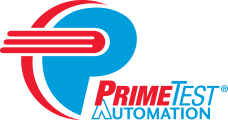From robotic devices and vision systems to bar code readers and a plethora of I/O modules, there are quite a few components performing a variety of functions on any factory floor. To work properly, all of these devices, which typically come from numerous suppliers, must reliably communicate and exchange data with each other, the control system, and the human-machine interface (HMI). This communication can be done using a variety of industrial protocols. At PrimeTest Automation, we use Ethernet/IP in many of our systems because we believe it is one of the most comprehensive and cost-effective industrial protocol for a variety of reasons.
The Advantages of Ethernet/IP
First, Ethernet/IP is a widely supported protocol that can be used with hundreds of devices. For example, with Ethernet/IP, we can build an automation system that uses a Fanuc robot, an Allen-Bradley programmable logic controller (PLC), and a Parker motor drive, and easily have each component communicate with each other. Because this communication protocol is widely adopted throughout the industry, we can select the best component for a particular job rather than being limited to devices from certain manufacturers. Additionally, Ethernet/IP allows for maximum flexibility for future system expansion, including the ability to add digital I/O or remote sensors at any time.
Using Ethernet/IP also helps us save time and money for our clients when we are designing and developing a system. Ethernet/IP can perform control and configuration management as well as exchange data, where as some protocols only allow you to exchange data. Thus, only Ethernet cables are needed for communication. This inherently cuts down on the amount of wiring required for a system, which reduces wiring costs, and saves time and money when designing the wiring into the system as well as the labor needed to run the wiring.
The Ethernet/IP protocol also allows manufacturers to collect more information from their devices. For example, Ethernet/IP can be used to communicate the power usage or temperature of a motor. This data can be used for better diagnostics or predictive maintenance, which helps us develop more intelligent machines with more uptime, resulting in further cost savings.
.jpg?width=640&name=11602%20Velcro%20Shipping%20%20052%20(1).jpg)
A system that is using minimal wiring for communication as a result of EtherNet/IP.
Potential Pitfalls of Ethernet/IP
As with any technology, there are some potential drawbacks to using Ethernet/IP. For example, using Ethernet/IP typically adds a large amount of traffic to the network and also presents potential network security threats since your entire manufacturing system is connected to your network. This means automation engineers now need to consider network design and security when developing the automation system or a network engineer needs to be added to the project, which is an additional expense. At PrimeTest Automation, we feel these items can be easily addressed through proper system design and the benefits of using Ethernet/IP far outweigh any potential drawbacks.
Overall, we believe Ethernet/IP is the right communication system to use for industrial automation systems, regardless of their size or complexity. For example, recently, we developed a robotic assembly system that uses an Allen-Bradley compact logic controller to interface with 38 nodes over Ethernet/IP. The system includes six robots, several vision systems, three bar code records, and 16 other devices, and all of the components are communicating seamlessly and flawlessly.
To learn more about what PrimeTest can do for you, visit our Core Competencies page.



 PrimeTest Automation will consistently provide products and services utilizing the latest technologies that meet or exceed the requirements and expectations of our customers. We will actively pursue improvements in quality through programs that benefit the growth of each employee and systems that promote efficiency throughout our organization.
PrimeTest Automation will consistently provide products and services utilizing the latest technologies that meet or exceed the requirements and expectations of our customers. We will actively pursue improvements in quality through programs that benefit the growth of each employee and systems that promote efficiency throughout our organization.